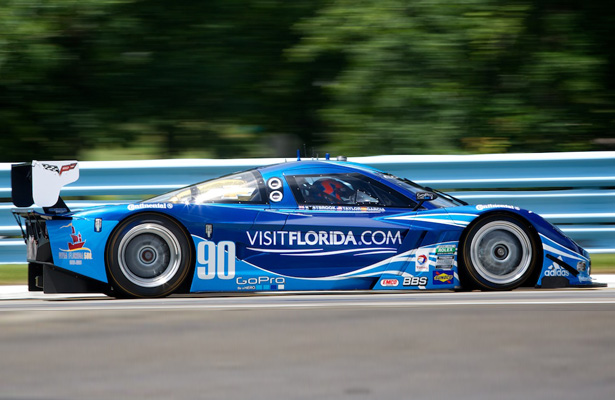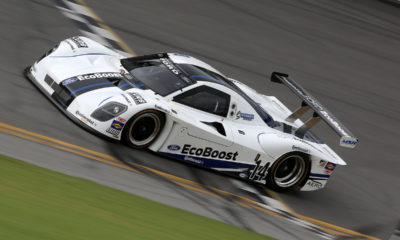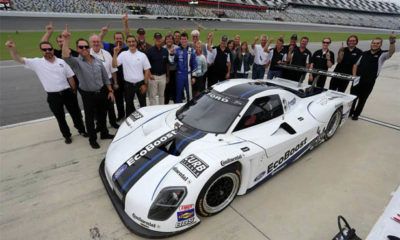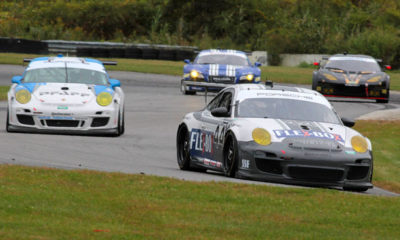
Photo: John Dagys
In what could be described as the first glimpse towards the future, officials from United SportsCar Racing witnessed the first on-track test for a modified Daytona Prototype earlier this week.
Sportscar365 has learned that Spirit of Daytona Racing conducted a single-day test at Roebling Road Raceway Tuesday, with a self-modified Corvette DP outfitted with a duel element rear wing and underbody tunnels.
Ricky Taylor, along with Eric Curran and Boris Said, who will both drive the SDR-supported Marsh Racing Corvette next year, were in attendance to evaluate different aero packages on the Coyote-chassied DP.
As team owner Troy Flis explained in an exclusive interview, the test was not sanctioned by IMSA but rather run entirely by the Florida-based squad itself. Flis invited USCR Chairman Jim France and tech chief Scot Elkins to attend, in the hopes of helping the Balance of Performance process underway between DP and P2 cars.
“In my years of being in GRAND-AM, I know there’s a lot going on and everybody’s [complaining] about the rules and making decisions and all this,” Flis said. “I think GRAND-AM is trying their best and I think they’re trying hard. Can they do better? Maybe, maybe not. I don’t know.
“My biggest fear is that there’s a lot of technology in this sport. We use a lot of simulations and CFD stuff. We use a lot of stuff to our advantage. But I’ve also seen that stuff not always be right. As a team owner, the end result is the buck stops here.
“At the end of the day, I have to find the money to go do it. I felt that any information I can give them, good, bad or different [would be useful].”
Flis and the SDR squad tested a number of different configurations, including its self-made underbody tunnel, which utilized the Coyote chassis’ existing floor. While reluctant to give numbers, the longtime GRAND-AM team owner admitted it delivered significant gains in downforce.
“There was an improvement across the board: Downforce, drag, lap time, all that was better,” he said. “I don’t want anybody blowing it out of the water. What we do know is that there was a large increase in percentage of downforce gained by it, which is a good thing.
“It was inexpensive for us to do and an easy test for us to do. I think it was a very successful test on the repeatability. We ran a lot of baseline stuff and ran the car in different attitudes, so it wasn’t just a one-off. We have all the proof to show what it did.”
According to Elkins, the unofficial test proved useful in validating IMSA’s initial simulations.
“Part of what they did added to the package of what we’re working on it right now,” Elkins told Sportscar365. “That gave us a couple of data points. It’s always tricky with on-track aerodynamic testing but it gave us a solid direction and helps the process.”
The next step in IMSA’s process, Elkins says, is the finalization of its in-house design of the rear wing and diffuser before a test piece is produced. Elkins doesn’t expect any other significant aero changes to be made to the DPs.
“We’re finalizing some of the design work on the aerodynamic components within the next week,” he said. “Once we do that, we’ll start making some parts and do wind tunnel validation. Once we do that, we’ll take those parts and go to the track.
Elkins would not reveal IMSA’s timeline for its own on-track testing to begin, but it’s understood official USCR testing at Daytona and Sebring will begin in mid-November.
Flis, meanwhile, is planning additional tests at Roebling Road in the next 30 to 45 days to evaluate other new-for-2014 components, including a six-speed gearbox and paddle shift systems.
“Hopefully we don’t get caught in November and say, ‘Oh we have to change the parts because they don’t work anymore.’ That’s what I don’t want to see happen,” Flis said.
























